Just to introduce a weird note into the forum. I was given a large supply of old seed, and am testing it for viability.
Picture of two nicked and soaked twenty-year-old seeds of Astragalus sobolevskiae, JJH 951081. I could find nothing at all about this species, other than it was described by Antonina Vasilevna Polozhij (1917-2003), and then collected by Halda at 2400 meters in the Altai.
Obviously, a plant so rare, it's never even heard of itself.
"We will sow no seed before its time."
Comments
Yeah; Plantarium lists it,
Yeah; Plantarium lists it, but has no images. I have a number of these weird Asian astragalus, some of which have pictures.
A lithophilus. http://www.plantarium.ru/page/image/id/193576.html
A. testiculatus. http://www.plantarium.ru/page/image/id/194072.html
I guess the seed is viable.
I guess the seed is viable. Astragalus sobolevskiae seed, today. (On filter paper.)
I have a difficult time getting astragalus seedlings from pots out into the garden, and wondered what sort of paper tube I might be able to use, to grow the seedlings in, and then transplant directly into the garden.
And then it came to me.
Ha, yes! Always available.
Ha, yes! Always available. A paper towel roll might be even better, for the additional length. Do you actually do this? If so, do you find that these light cardboard rolls hold up to wetting? I'd guess they'd unroll when saturated? I've never tried this, or paper pots, for that matter. Of course, for me, the indoor growing season is usually from January or early February to early May. I'm sure you're able to plant things out much earlier (notwithstanding the pathetic whining, duly noted in your other post, about your current cold spell ;-) ) so any sort of non-plastic/ceramic pot breaking down may be much less of a concern for you, I'd guess?
I have some experience in
I have some experience in this matter. Tried to twine the stems of a wisteria around a long, heavy paper roll (used for mailing a map, or something similar). The first time it got wet, it fell over.
My watering regime, for seedlings of all kinds, is with a plastic squirt bottle. (The kind that eventually stop working.) So maybe the roll won't get that wet.
I was pleased to see the germination; also on Astragalus hirticalyx, which I've grown before and know is excellent. This from Jurasek seed collected 1991 or so.
Also in my experience, roots
Also in my experience, roots of astragalus, oxytropis, and ebenus are ultra-senstive to root disturbance, and the root hairs can attach themselves to plastic pots in a way that makes it very difficult not to kill the plant trying to transplant it.
I've had some success (one percent, which is better than zero) nicking the seed, soaking it, and then sowing it in situ. It strikes me that the ultimate way to success might be to sow them as I did on filter paper, maybe in June, and then plant the seedlings once they've germinated. I'm going to try that next spring. That is, assuming a certain region can keep its air to itself at that time .....
Perhaps if we all breath in
Perhaps if we all breath in at once and hold it... ;-)
Yes, I suppose root sensitivity may explain my failures in getting some of these established once planted out (or at least I prefer that explanation to the other one I had in mind, which was more akin to general incompetence).
I never rule out stupidity. I
I never rule out stupidity. I don't know if you're on the Pacific Bulb Society mailing list, but I complained bitterly there about some old (>10 years) oncocyclus iris seed not germinating after eleven months in the refrigerator, and was told I was doing it all wrong. As soon as I followed the instructions I had germination. Like within days.
I kept checking the seeds, wondering why nothing had happened. For eleven months.
Maybe, nicking the astragalus seed, soaking it overnight, and then putting it on filter paper, in a plastic bag, not entirely closed, then when the seed has germinated, either sowing the seed, or the seed and part of the filter paper, might be a good way to go.
I've tried nicking and sowing direct, but I think rot usually sets in before germination. People do the same thing with corn, "pre-sprouting" the seed.
Speaking of pea things, and
Speaking of pea things, and dumb behavior, I did manage to germinate one of these http://www.pavelkaalpines.cz/Photos/MakedonieNepalTurecko2013/hedysarumhuetii1500mdarendeturkey.html using the outdoor method, transplanted it successfully, and then, with the rest of the seed, had the bright idea of removing the wings (forget what they're called) to get to the seed, and then nicked it, and sowed it direct, and that was the end of that.
It was more like an interment than sowing.
It's one thing to do dumb
It's one thing to do dumb stuff, and another to have it revealed in public (like the iris seed business).
I had two nice plants of Convolvulus compactus, growing in sand, but in too much shade, and so I decided to transplant them, which you can do if the plants aren't too old. So week before last I dug them up ......and I have no idea where they went. I've looked all over for them. Gone.
You make me laugh, Bob, but I
You make me laugh, Bob, but I'm also laughing at myself. When I have too many seed pots that have to be planted out, I'll go around the garden trying to find just the right spot. Of course, later I can't remember where I stuffed the plants. Lucky for me, things grow in spite of me.
...Claire
I have no idea where the
I have no idea where the plants went. One reason I went back to using a lot of labels......
Incidentally, not a Siberian astragalus, but a Turkish one, Astragalus hirticalyx (a beauty), from Jurasek seed, collected 1991 or 1992, germinated on filter paper.
And the two seeds of A. sobolevskiae, today. (I posted these on the SRGC website too, in hopes that someone might say they grew this plant and it wasn't a weed.)
I've done the nicking,
I've done the nicking, soaking, refrigerator method for astragalus seed, but I put some damp Turface in the bag. It was pretty successful.
Nicking and soaking bypasses
Nicking and soaking bypasses the need for any kind of cold treatment. The astragalus seed pictured germinated within hours of being soaked; maximum was less than two days. Works with other fabaceous species, oncocyclus iris (and, I hear, other iris) seed, some cactus, and calochortus seed too.
Some species apparently need cold to develop the embryo, but when the embryo is already fully formed in the seed, it is simply waiting for something to rupture the seed coat. That's where I and my watchmaker's loupe and razor blade come in.
(The technique for forced germination of calochortus needs to be refined a little, because I noticed the emerging embryos were prone to rot, and, anyway, the seeds respond readily to cold treatment.)

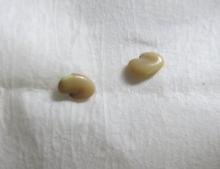
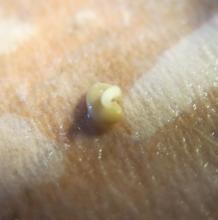
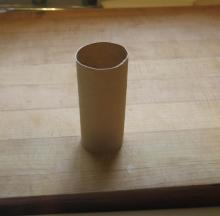
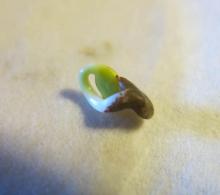
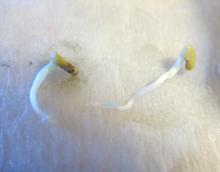
Well, seems to be an accepted name, in any case:
http://www.catalogueoflife.org/col/details/species/id/11487603